Bryan L. Programmable controllers. Theory and implementation
Подождите немного. Документ загружается.

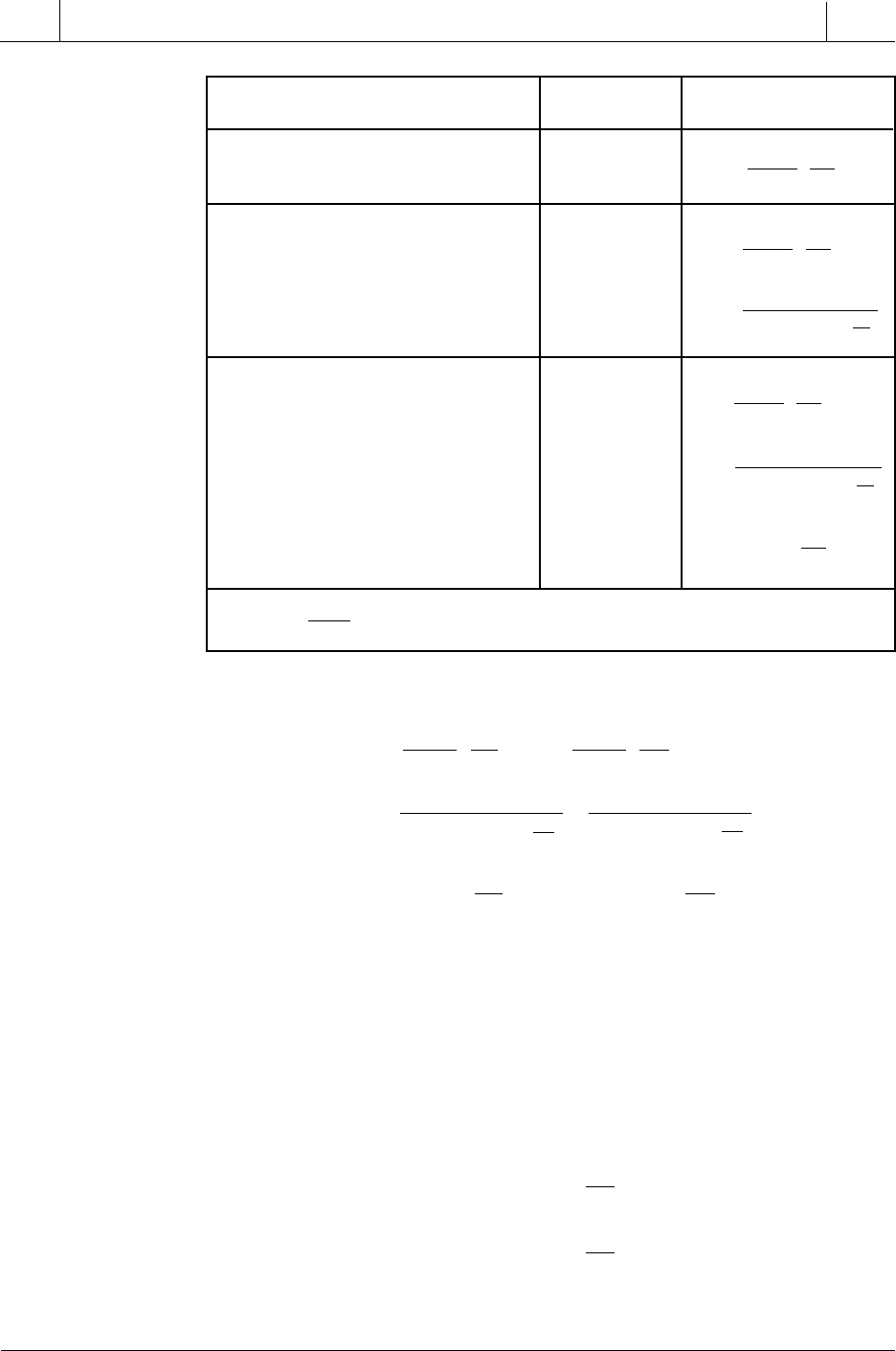
759
CHAPTER
15
Process Controllers
and Loop Tuning
SECTION
4
PLC Process
Applications
Industrial Text & Video Company 1-800-752-8398
www.industrialtext.com
Table 15-4. ITAE open-loop tuning equations.
Type of Controller
Loop Tuning
Constant
Tuning Equation
Proportional-Integral-Derivative (PID)
Proportional-Integral (PI)
Proportional (P)
K
P
T
I
T
D
T
I
K
P
K
P
K
K
D
P
T
=
−
0 490
1 084
.
.
τ
K
K
D
P
T
=
−
0 586
0 916
.
.
τ
T
I
T
D
=
−
()
τ
τ
1 03 0 165..
K
K
D
P
T
=
−
0 965
0 855
.
.
τ
T
I
T
D
=
−
()
τ
τ
0 796 0 147..
T
D
D
T
=
0 308
0 929
.
.
τ
τ
Note:
K
PV
CV
=
∆
∆
PID mode: K
K
D
T
T
D
P
T
I
D
T
D
T
=
=
=
=
−
()
=
−
()
=
=
=
−
−
0 965 0 965
15
5
85
1 013
0 796 0 147
85
0 796 0 147
11 980
0 308 0 308 8 5
5
85
0 855
0 855
0 929
5
85
..
..
.
..
.
..
. min
.(.)(.)
.
.
.
.
.
τ
τ
τ
τ
τ
=
0 929
1 599
.
. min
In the ITAE loop tuning method, the controller settings ensure a damping
ratio of less than 1/8 for the P and PI modes. The PID mode, however, still
presents a problem in systems with large dead times, although this problem
is not as severe as it is in the Ziegler-Nichols open-loop method. This problem
stems from the fact that the exponent of the derivative action (0.929) term T
D
is close to the value of 1, which makes an approximate value of T
D
be 0.308
times the value of the dead time:
T
D
D
D
D
T
T
T
≈
≈
≈
≈
0 308
0 308
0 308
1
.
.
.
τ
τ
τ
τ
K
K
D
P
T
=
−
0 490
1 084
.
.
τ
K
K
D
P
T
=
−
0 586
0 916
.
.
τ
T
I
D
T
=
−
()
1 03 0 165..
τ
τ
K
K
D
P
T
=
−
0 965
0 855
.
.
τ
T
I
D
T
=
−
()
0 796 0 147..
τ
τ
T
D
D
T
=
0 308
0 929
.
.
τ
τ
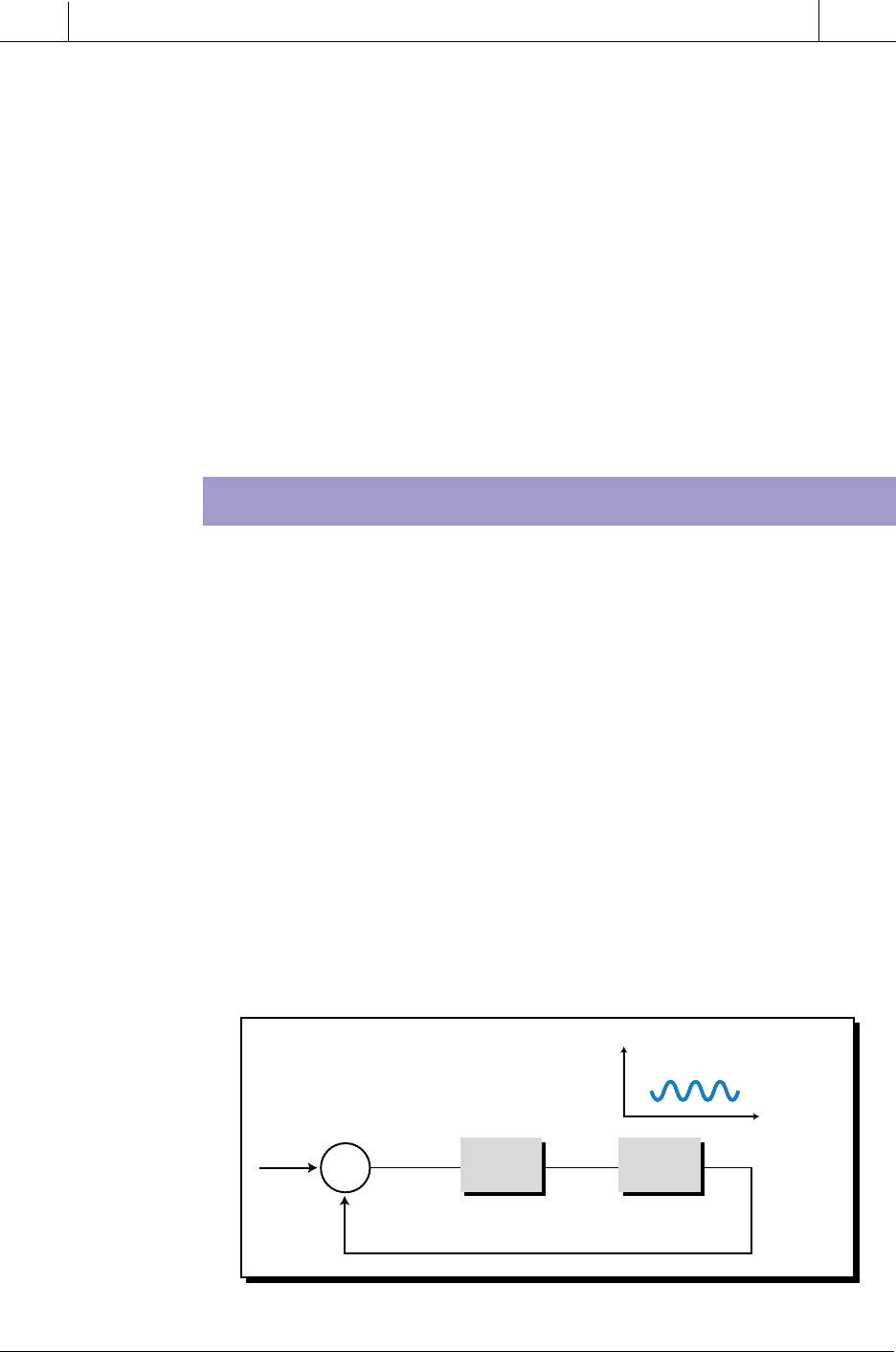
760
SECTION
4
PLC Process
Applications
Industrial Text & Video Company 1-800-752-8398
www.industrialtext.com
CHAPTER
15
Process Controllers
and Loop Tuning
HpHc
EPV
PV
SP
+
–
Σ
PID
Increase
K
P
until...
PV
t
… a constant amplitude
oscillation occurs
Figure 15-85. Ziegler-Nichols closed-loop tuning method.
As discussed earlier, a derivative term proportional to the dead time can
cause an aggravating response in the system that affects the overshoot.
This problem in the ITAE method, however, is less pronounced than it is
in the Ziegler-Nichols open-loop method where T
D
= 0.5D
T
when L
t
= D
T
.
Note also that the ITAE method does not contain a fixed ratio constant of
T
D
/T
I
, which is the case in the Ziegler-Nichols open-loop method (T
D
/T
I
=
1/4). Therefore, the ITAE method cannot cause a potential imbalance in the
PID controller equation.
Derivative control action should not be used in processes with large dead
times. As a de facto rule of thumb, a large dead time is one in which the
ITAE open-loop test produces a value of D
T
that is greater than τ. If this is
the case, then T
D
should be set to zero, implementing control without
derivative action.
ZIEGLER-NICHOLS CLOSED-LOOP TUNING METHOD
The Ziegler-Nichols closed-loop tuning method is used to obtain the
controller constants [K
P
, K
I
(or T
I
), and K
D
(or T
D
)] in a system with feedback.
This technique allows for the tuning of processes, such as servo positioning
systems, that cannot run in an open-loop environment.
The main objective of the Ziegler-Nichols closed-loop method is to find the
value of the proportional-only gain that causes the control loop to oscillate
indefinitely at a constant amplitude (see Figure 15-85). This gain, which
causes steady-state oscillations, is called the ultimate proportional gain
(K
PU
). Another important value associated with this proportional-only control
tuning method is the ultimate period (T
U
). The ultimate period is the time
required to complete one full oscillation once the response begins to oscillate
at a constant amplitude. These two parameters, K
PU
and T
U
, are used to find
the loop-tuning constants of the controller (P, PI, or PID). To find the values
of these parameters and to calculate the tuning constants, you must do the
following:
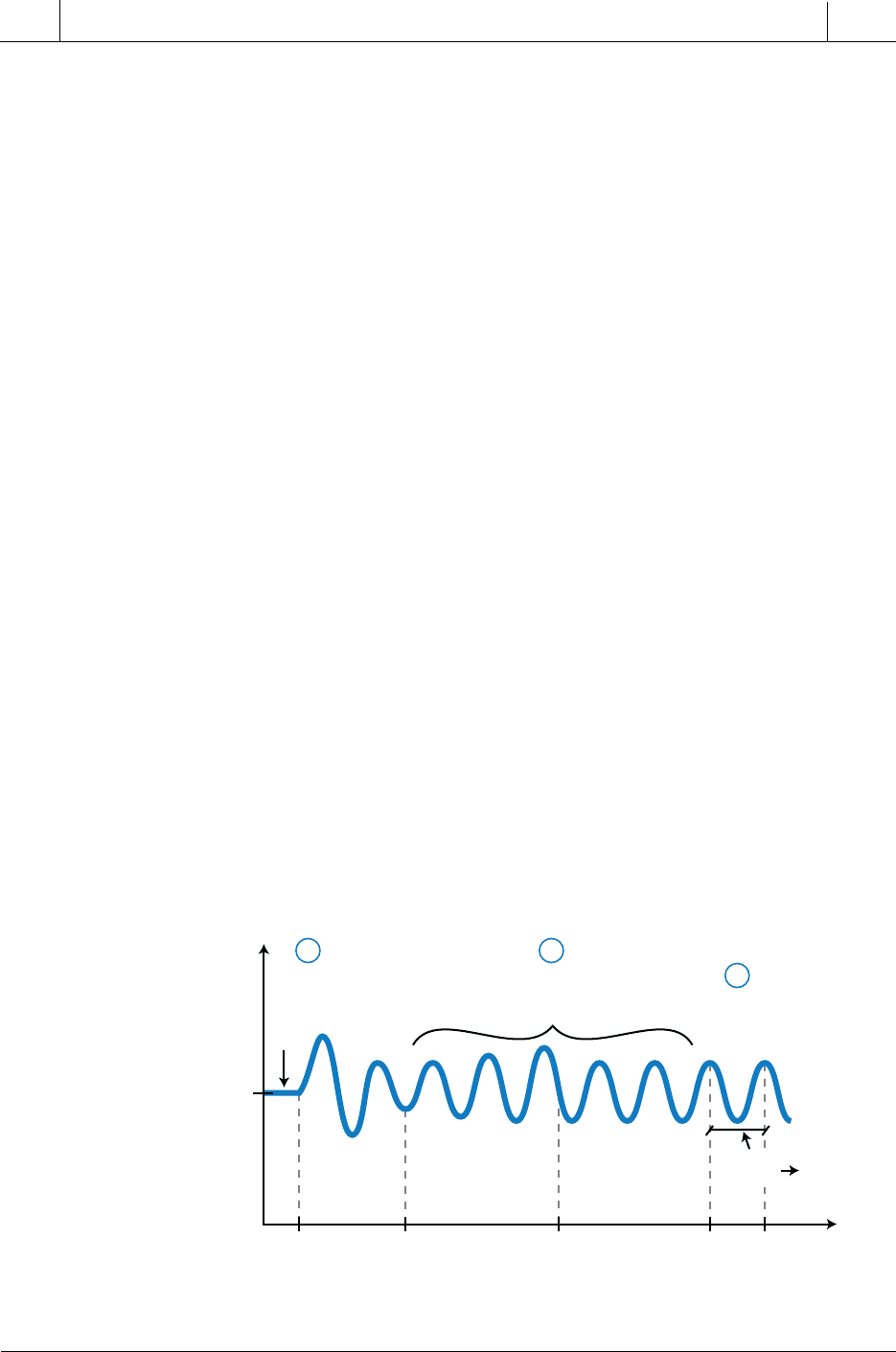
761
CHAPTER
15
Process Controllers
and Loop Tuning
SECTION
4
PLC Process
Applications
Industrial Text & Video Company 1-800-752-8398
www.industrialtext.com
1. Implement proportional-only control. Remove all integral and
derivative actions. In most controllers, the removal of integral time
(T
I
) is done by setting T
I
equal to 999 (or its largest number) or by
setting K
I
equal to 0. To remove the derivative action, set K
D
(or T
D
)
to 0. Place the controller in automatic mode with the control variable
and process variable at 50%.
2. Create a disturbance in the system. Create a small disturbance in
the loop by slightly changing the set point (see point A in Figure
15-86). Start increasing the proportional gain, or lowering the
percentage proportional band (%PB), until the process variable
begins to oscillate (point B). Continue to increase and decrease the
gain until the oscillations have a constant amplitude (point C).
Record this response and determine the ultimate proportional gain
and ultimate period.
In the example system in Figure 15-86, the set point of 150°F is
slightly changed to 155°F while the gain is increased to K
D
= 3
(point A). Once the oscillation starts, the set point is returned to
150°F. The oscillation begins to decay at t
2
, so the gain is increased
again to K
P
= 4 (point B), However, the response starts to grow in
amplitude at t
3
, so the gain is reduced to K
P
= 3.5. At this point, the
response exhibits a constant amplitude oscillation (point C). There-
fore, the ultimate gain (K
PU
) is 3.5 and the ultimate period (T
U
) is 10
minutes.
3. Calculate the constants. Plug the K
PU
and T
U
values into the
Ziegler-Nichols closed-loop tuning equations to determine the
settings for the controller to be used. Table 15-5 provides the tuning
equations for this closed-loop method.
Figure 15-86. System tuned using the Ziegler-Nichols closed-loop tuning method.
150°F
PV
t
(min)
K
P
= 3
(not enough)
K
P
increased
again
K
P
decreased
T
U
= 10 min
K
P
= 4
(too much)
K
P
= 3.5
K
PU
= 3.5
t
1
t
2
t
3
10 min 20 min
Constant
amplitude
oscillation
Ultimate
Period
C
A B
Set point
changed slightly
and
K
P
increased
to 3
Alter
K
P
until oscillations
are constant
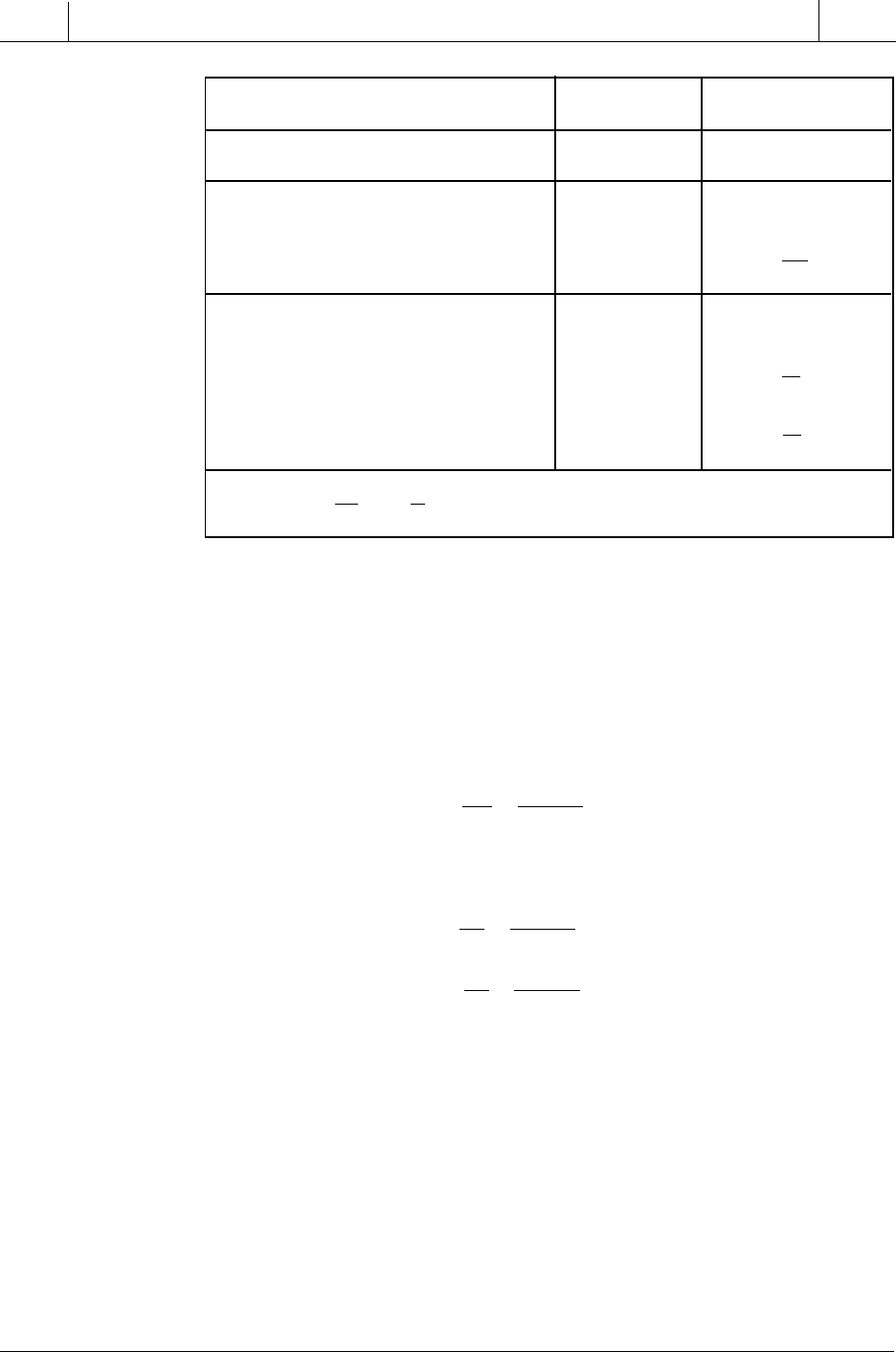
762
SECTION
4
PLC Process
Applications
Industrial Text & Video Company 1-800-752-8398
www.industrialtext.com
CHAPTER
15
Process Controllers
and Loop Tuning
Table 15-5. Ziegler-Nichols closed-loop tuning equations.
For the example system in Figure 15-86, the tuning constants for each
controller mode will be:
P mode :
KK
PPU
===(.)( ) (.)(.) .05 05 35 175
PI mode :
KK
T
T
PPU
I
U
===
== =
(. )( ) (. )(.) .
.
min
.
. min
045 045 35 1575
12
10
12
833
PID mode:
KK
T
T
T
T
PPU
I
U
D
U
===
== =
== =
(.)( ) (.)(.) .
min
min
min
. min
06 06 35 210
2
10
2
5
8
10
8
125
The magnitude of the constant oscillation amplitude is not important in the
Ziegler-Nichols closed-loop tuning equations; however, all the elements in
the loop must be within operating range. For example, the control variable
must not vary from fully open to fully closed to create the oscillation.
The Ziegler-Nichols closed-loop method provides a quarter-amplitude re-
sponse. This response is acceptable for P and PI modes; however, in PID
mode, it presents the same equation imbalance as experienced in the
Ziegler-Nichols open-loop technique. Again, this is due to the fixed ratio of
the derivative time to the reset time.
Type of Controller
Proportional (P)
Proportional-Integral (PI)
Proportional-Integral-Derivative (PID)
Loop Tuning
Constant
Tuning Equation
K
P
T
I
T
D
K
P
K
P
T
I
KK
PPU
=( . )( )05
KK
PPU
=( . )( )045
T
T
I
U
=
12.
KK
PPU
=( . )( )06
T
T
I
U
=
2
T
T
D
U
=
8
Note: %;;
PB
K
K
T
KT
P
I
i
DD
===
11

763
CHAPTER
15
Process Controllers
and Loop Tuning
SECTION
4
PLC Process
Applications
Industrial Text & Video Company 1-800-752-8398
www.industrialtext.com
Another problem with this closed-loop technique is that the majority of
process control loops in manufacturing operations cannot tolerate oscilla-
tions for long periods of time, especially if many trials are necessary. The
time required to obtain a steady-state oscillating response is typically 30–60
minutes, but it can take up to several hundred minutes. The Ziegler-Nichols
closed-loop method can be slightly altered to avoid this time problem.
ALTERED ZIEGLER-NICHOLS CLOSED-LOOP
TUNING METHOD
The altered version of the Ziegler-Nichols closed-loop method provides an
approximation of the desired quarter-amplitude response. The test procedure
in this method reduces the time required to observe the process variable’s
steady-state response to a change in controller output. Instead of changing the
value of CV (through the inverse of the proportional gain) until PV exhibits
a constant amplitude oscillation, this altered method compares the responses
of several trials until an approximate quarter-amplitude response is obtained.
The procedures and steps used in this altered method are the same as in the
standard Ziegler-Nichols closed-loop method, where several trials are per-
formed by changing the proportional gain until the response approximates a
quarter-amplitude response.
Once the process variable response approximates a quarter-amplitude re-
sponse, the chart recorder records the period of decaying oscillation (see
Figure 15-87), as well as the gain of the proportional action. The gain and
decaying oscillation period for this quarter-amplitude test are called K
1/4
(quarter-amplitude gain) and T
1/4
(quarter-amplitude period), instead of K
PU
and T
U
. These K
1/4
and T
1/4
parameters are then plugged into the standard
Ziegler-Nichols closed-loop tuning equations (shown previously in Table
15-5) in place of K
PU
and T
U
, respectively. The values of K
PU
and T
U
will be:
Figure 15-87. Quarter-amplitude test.
150°F
PV
t
Step Change
Gain
K
1/4
is the proportional gain that
causes the chosen chart response.
T
1/4
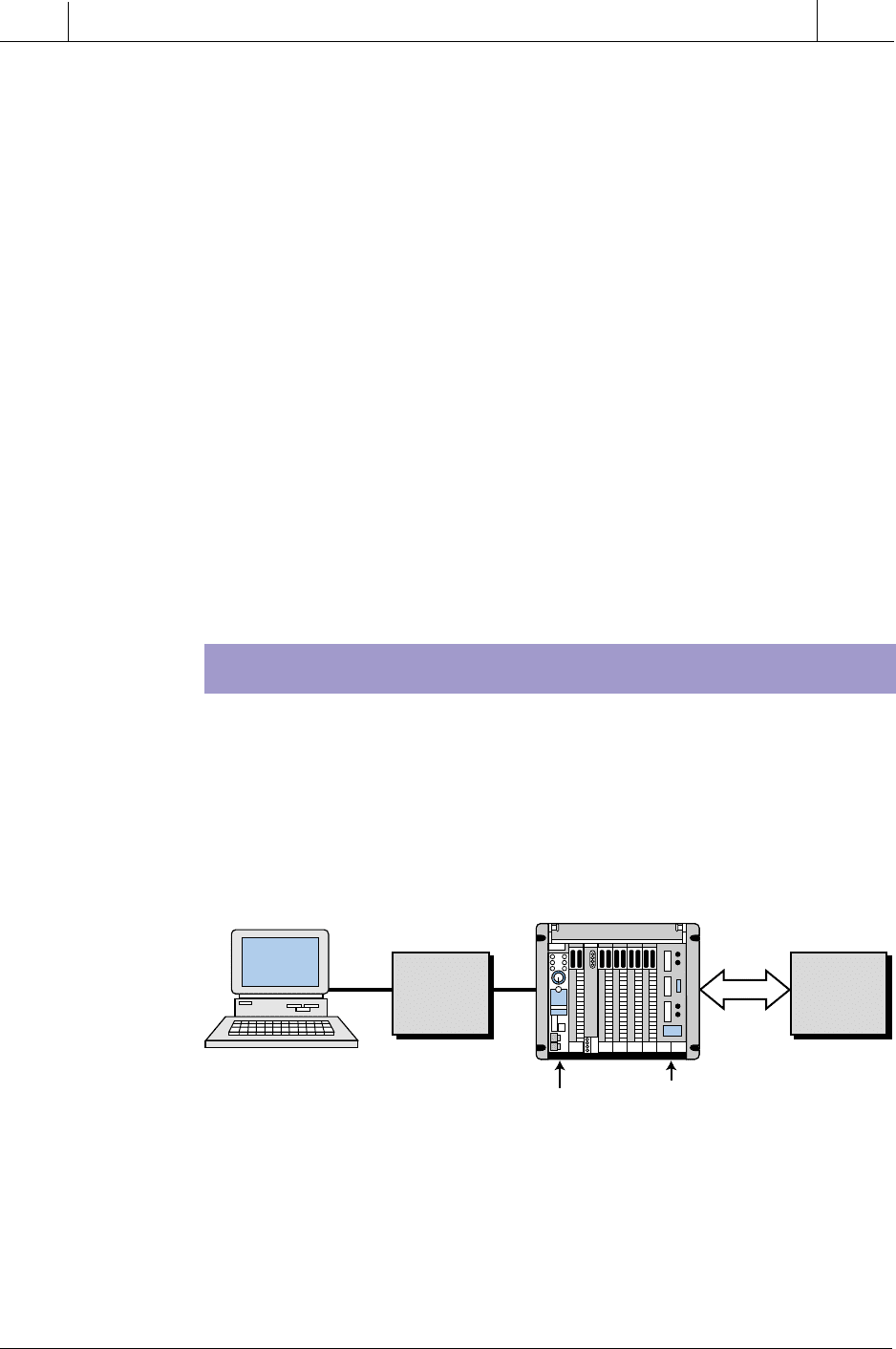
764
SECTION
4
PLC Process
Applications
Industrial Text & Video Company 1-800-752-8398
www.industrialtext.com
CHAPTER
15
Process Controllers
and Loop Tuning
PID
Tuning
Software
Process
PLC
Processor
PID
Interface
Figure 15-88. Software loop tuning.
SOFTWARE TUNING METHODS
Another method for tuning PID controllers is the use of software tuning
systems. These software packages run on personal computers using Unix,
Windows, or another platform (see Figure 15-88). They connect to the
controller or PLC either directly or via a DDE (dynamic data exchange)
interface. These software systems reduce the tuning time and, at the same
time, optimize control loop performance.
KK
TT
PU
U
=
=
2
14
14
/
/
This is due to the fact that the proportional gain in the standard Ziegler-
Nichols method is:
KK
K
K
PPU
=
=
()
=
05
052
14
14
.
.
/
/
The values that will be obtained for T
I
in the integral action of the PI mode and
for T
I
and T
D
in the integral and derivative actions of the PID mode will be
slightly larger than those values calculated through the unaltered Ziegler-
Nichols closed-loop method, since the T
1/4
reading will be slightly larger than
the T
U
reading. Although this method avoids the problem of long test
periods, it does present another problem—the determination of the period of
decaying oscillation. Reading a decaying oscillation period is more difficult
than reading a period of constant amplitude oscillation, because it is harder to
ascertain where the decaying sinusoidal curve’s middle section is.
Software tuning programs provide numerous viewing selections, windows,
and on-line help screens that show process characteristics including simula-
tions, modeling, plots, and frequency responses (see Figure 15-89). Addition-
ally, they provide important information about the process itself that can be
extremely difficult, if not impossible, to obtain manually. For example,
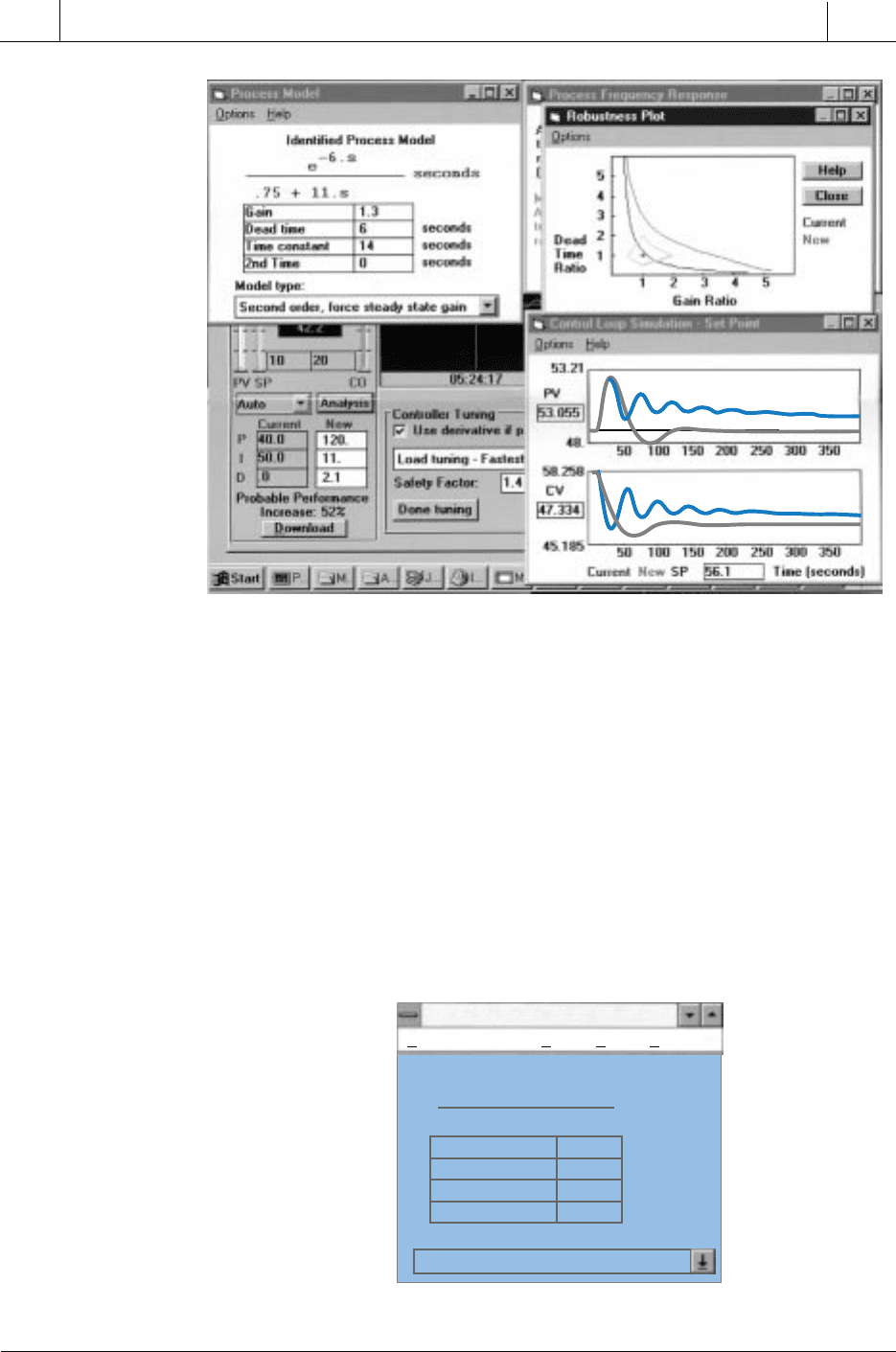
765
CHAPTER
15
Process Controllers
and Loop Tuning
SECTION
4
PLC Process
Applications
Industrial Text & Video Company 1-800-752-8398
www.industrialtext.com
ExperTune
®
, by ExperTune, Inc., identifies the transfer function of the
process during the tuning test (see Figure 15-90), thus providing information
such as process gain, dead time, and lag time constants. This software
optimizes the PID tuning parameters automatically for even the most compli-
cated of processes. It also performs tuning for cascade PID loops. Addition-
ally, it provides a “robustness” plot, which shows how a change in the process
dead time and/or gain will affect the closed-loop system’s stability given the
current loop tuning constants. In fact, the robustness plot shows all the gain
and dead time values that will allow for stable closed-loop operation. For
example, it shows how a change in gain will affect the stability of the closed-
loop system as it is tuned. Thus, the robustness plot provides a quick look at
the trade-offs between tuning and stability.
Figure 15-89. Software tuning program screens showing process characteristics.
Figure 15-90. Process transfer function obtained through software loop tuning.
Courtesy of ExperTune, Inc., Hubertus, WI
Courtesy of ExperTune, Inc., Hubertus, WI
Config Simulator DMC Close Help
ExperTune Process Modeler
Identified Process Model
-4.s
seconds
seconds
seconds
seconds
e
1 . 4 + 11 . s + 24 . s
2
Gain
Dead time
.74
4
Time constant
2nd Time constant
imaginary
imaginary
Model type:
Second order, force steady state gain

766
SECTION
4
PLC Process
Applications
Industrial Text & Video Company 1-800-752-8398
www.industrialtext.com
CHAPTER
15
Process Controllers
and Loop Tuning
Software tuning systems also allow “what if” analysis, meaning that they
suggest new controller constants given hypothetical process values. They
can also provide PID tuning parameters from ASCII data files about the
plant process. These features reduce the amount of time required to tune the
system because they can produce a database of tuning constants for a variety
of process scenarios. These software tuning systems greatly benefit users
wanting to simplify their process tuning efforts while reducing the amount of
time required for manual tuning.
15-13 SUMMARY
A controller in a process control system receives data about the set point
value and the actual process variable value and then compares these values
to generate an error value. The controller uses this error value according to a
control algorithm to manipulate the control variable. The control variable
directs a final control element (e.g., a valve) to bring the process variable to
the desired set point, eliminating the system error. A controller is direct
acting if its output increases in response to an increase in the process
variable; it is reverse acting if its output decreases in response to an increase
in the process variable.
There are two types of controller modes: discrete and continuous. Some of
the most commonly used discrete-mode controllers are the two-position, or
ON/OFF, mode and the three-position mode. Two-position controllers turn
the output ON (100% open) or OFF (0% open) once the process variable
crosses an error deadband around the set point. Three-position controllers
are an extension of two-position ones in the sense that they have one more
output level. This type of discrete controller provides 0%, 50%, and 100%
controller output levels.
Continuous-mode controllers include proportional controllers, integral con-
trollers, and derivative controllers. These controllers can also be combined to
provide proportional-integral (PI), proportional-derivative (PD), and propor-
tional-integral-derivative (PID) controllers.
In proportional control, the corrective output action is proportional to the
size of the error deviation (E = SP – PV). This type of control provides a fast
response and is relatively simple to implement. Proportional control, how-
ever, always leaves some offset error between the desired and actual values
of the process variable. If the proportional band in a proportional controller
is set too wide, the offset error will be larger than if the proportional band is
narrow. However, too narrow of a proportional band will create oscillation
and, thus, system instability.
Integral control provides corrective action as a function of the integral of the
error (i.e., the sum of the error over time). It provides its highest gain, or
corrective action, at low frequencies (i.e., in a slowly changing process).

767
CHAPTER
15
Process Controllers
and Loop Tuning
SECTION
4
PLC Process
Applications
Industrial Text & Video Company 1-800-752-8398
www.industrialtext.com
Integral action tends to ignore high-frequency changes, such as noise or
rapid transients, in the process. Although this control mode eliminates the
inherent offset error present in a proportional controller, it adversely affects
stability. If the integration time is reduced, the response during the slow
period of the process will become faster, inducing cycling.
Derivative control provides corrective action as a function of either the rate
of change of the error or the process variable. A derivative controller provides
its highest gain, or corrective action, at high frequencies. Hence, it provides
an anticipatory response to the process variable change. The derivative mode
cannot be used alone and does not eliminate residual error.
A proportional-integral, or PI, controller combines the fast response of
proportional action with the offset error elimination of integral action. A PI
controller with an integral time that is too long will exhibit a response that
will take a long time to return to the set point. Conversely, a shorter integral
time will cause the process variable to cross the set point faster, resulting in
damped oscillations. An integral time that is too short, however, will produce
continuous oscillations.
A proportional-derivative, or PD, controller provides better response stabil-
ity than a PI controller, but it does not provide offset error elimination. A
PD controller is useful in applications where the process has a long lag time
delay in its recovery from a disturbance. The derivative action in this
controller provides a lead function, which cancels some of the process lag
and allows the proportional band to become narrower. This improves re-
sponse and stability. A PD controller does not eliminate offset error, but a
narrower proportional band can reduce the amount of residual error in the
system. A derivative time constant (K
D
or T
D
) that is too long will cause the
process variable to change too rapidly and overshoot the set point with
damped oscillation. Conversely, if the derivative constant is too short, the
process variable will take too long to reach the set point.
A proportional-integral-derivative, PID, controller combines the increased
stability of a PD controller with the eliminated offset feature of a PI
controller. A PID controller can be used to control almost any type of process,
including those with long lag times. The gains for each of the control actions
in a PID controller can be derived experimentally utilizing several tuning
methods.
An integral, or reset, windup situation occurs when an integral action
saturates a controller’s output at 100%. Integral windup usually happens
during the start-up of a process. This condition occurs when the error in a
slow-responding process system is large. The proportional action tries to bring
the process variable closer to the set point, but the slow speed of the process
response and the presence of error induces the integral action to continue,
keeping the controller at 100% output. This condition can be prevented by
disabling the integral action once the controller’s output reaches 100%.

768
SECTION
4
PLC Process
Applications
Industrial Text & Video Company 1-800-752-8398
www.industrialtext.com
CHAPTER
15
Process Controllers
and Loop Tuning
Bumpless transfer refers to a controller’s ability to switch from manual to
automatic control and vice versa without a step change in the input to the
process. In a bumpless transfer, the manual controller station tracks the
automatic controller’s output and vice versa to keep the control variable
output constant.
Cascade control refers to an advanced control technique where the output of
one controller is the set point input to another controller. Cascade control
provides more precise control than noncascaded control, since the second-
ary (or inner) loop will react quickly to a disturbance before it starts to affect
the primary (or outer) loop.
Controller loop tuning is the process of manipulating the parameters (gains)
in a PID controller so that the response of the process system is satisfactory.
A satisfactory response is one that exhibits the desired speed of response, yet
meets the required accuracy and stability criteria. Control processes are
generally tuned under operating conditions, as opposed to start-up conditions,
so that the process variable is stable at an operating point. Since the transfer
function of a process is rarely known, experimental measurements and tests
can be made to obtain parameters that will help determine the desired
controller gains for PID control. These experimental measurements are
known as the “modeling” of the system. Some of the most popular experimen-
tal tuning methods are the Ziegler-Nichols open-loop method, the integral of
time and absolute error (ITAE) open-loop method, and the Ziegler-Nichols
closed-loop method.
During the modeling of a process, a known disturbance is created and the
resulting response is observed and recorded. The disturbance should be one
that actually occurs during process operation (e.g., a change in load, flow rate,
or speed of the system). However, the creation of this type of disturbance is
impractical to implement in a real-life situation; therefore, a change in set
point is most often used as the disturbance to the process. The values obtained
from this disturbance are then plugged into the tuning method’s equations
to obtain the values for the proportional, integral, and derivative gain terms.
These values are then used as the starting parameters for the controller, which
will provide process control by minimizing the error in the system.
cascade control
continuous-mode controller
derivative controller
direct-acting controller
discrete-mode controller
integral controller
integral of time and absolute error open-loop tuning method (ITAE)
integral windup
loop tuning
KEY
TERMS
